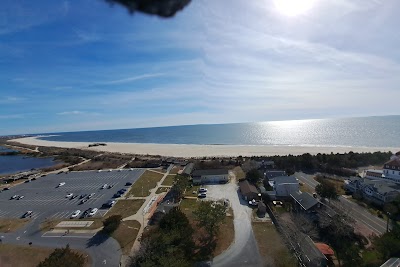Cape May Lighthouse (Cape May Lighthouse)
Overview
Discovering the Cape May Lighthouse in Misiones, Argentina
The Cape May Lighthouse in Misiones is a stunning landmark that combines historical significance with architectural charm. While some may mistakenly associate it with its namesake in New Jersey, USA, the lighthouse in Misiones stands out as a captivating site, attracting both history buffs and casual travelers. Nestled in a region renowned for its lush landscapes and rich cultural heritage, this lighthouse serves as a testament to Argentina's maritime legacy.
A Glimpse into History
Constructed in the late 19th century, the Cape May Lighthouse was built to enhance navigation along the Paraná River and its tributaries. During this transformative period, Argentina was expanding its infrastructure to facilitate growing trade and transportation routes. The lighthouse played a vital role in guiding vessels through the often treacherous waters, ensuring safe passage to various ports. The choice of the name 'Cape May' remains a mystery, possibly paying homage to the original Cape May Lighthouse and symbolizing a connection among maritime communities across the globe.
Architectural Marvel
Standing tall, the lighthouse showcases a harmonious blend of functionality and elegance. Its towering beacon is visible from miles away, serving as a constant reminder of the region's historical reliance on river navigation. Constructed with robust masonry designed to withstand local weather conditions, the lighthouse has endured the test of time. Visitors often admire the striking contrast between its bold silhouette and the vibrant greenery surrounding it, making it a popular subject for photography.
Panoramic Views
One of the highlights of visiting the Cape May Lighthouse is the breathtaking panoramic view from its summit. After ascending a series of winding steps, visitors are rewarded with stunning vistas of the Paraná River meandering through Misiones' lush landscape. This spectacular viewpoint not only offers a visual feast but also encourages reflection on the area's rich history and natural beauty.
A Symbol of Community and Resilience
The lighthouse holds significant historical value for the local community, symbolizing perseverance and progress during a time when river navigation was crucial for commerce and communication. Stories of early lighthouse keepers, who faced isolation to keep the light burning, add a human touch to its rich narrative. Local guides often share these tales, enriching the visitor experience with layers of history.
Cultural and Educational Significance
In addition to its historical importance, the Cape May Lighthouse serves as a hub for cultural and educational activities. Schools and universities frequently arrange field trips to the site, where students learn about maritime history, geography, and the critical role lighthouses play in trade and safety. Conservation groups also highlight the lighthouse’s significance in their efforts to preserve historical sites and promote environmental education, fostering a sense of pride in the community while ensuring its legacy for future generations.
Planning Your Visit
When planning your visit, note that the lighthouse is easily accessible via a well-marked path that meanders through some of Misiones' most beautiful natural scenery. A small admission fee is required, contributing to the maintenance of the lighthouse and its grounds. Guided tours are available in multiple languages, allowing international visitors to fully appreciate the historical context and significance of this remarkable site.
Exploring the Surroundings
Beyond the lighthouse itself, the surrounding area offers a wealth of attractions that can enhance your experience. The region is famous for its lush rainforests and is home to the iconic Iguazu Falls, one of the world’s most spectacular waterfall systems. Pairing your visit to the Cape May Lighthouse with other local attractions creates a well-rounded experience of what Misiones has to offer.
In conclusion, the Cape May Lighthouse in Misiones is more than just a navigational aid; it is a beacon of history, culture, and natural beauty. With its intriguing past and vital role in regional development, it is an essential stop for anyone exploring northern Argentina. As you venture through this historic landmark, you'll gain insights into the area's maritime history and the resilience of its people, all while soaking in the stunning views and serene atmosphere that make this location truly special.







